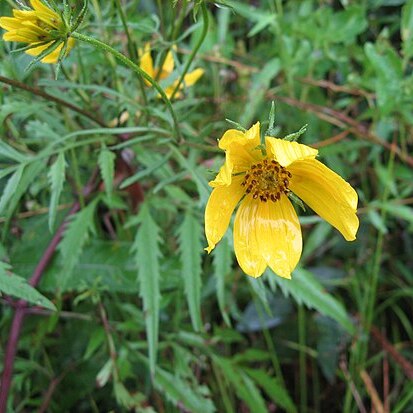Annuals (biennials), 30–100+ cm. Leaves: petioles 5–30 mm; blades ± deltate to ovate overall, 40–80(–150+) × 25–50(–80+) mm, usually laciniately 1-pinnatisect, ultimate lobes 3(–7), lanceolate to linear, 25–60(–120+) × (3–)6–20(–25) mm, bases cuneate, ultimate margins incised, dentate, or serrate, ciliate, apices acute to attenuate, faces glabrous or hirtellous to scabrellous. Heads borne singly or in 2s or 3s or in open, ± corymbiform arrays. Peduncles 10–20(–50) mm. Calyculi of 12–21+ spreading to reflexed, linear, seldom foliaceous bractlets (6–)8–12(–20+) mm, margins coarsely ciliate, abaxial faces glabrous or scabrellous. Involucres turbinate to hemispheric, 4–5 × 6–10 mm. Phyllaries 6–8+, lance-ovate to lanceolate, 4–7 mm. Ray florets 8; laminae golden yellow, 10–25+ mm. Disc florets (40–)60–100+; corollas yellow, 2.5–3 mm. Cypselae blackish or brown to yellowish, ± flattened, obovate or oblanceolate to cuneate, outer 5–7 mm, inner 7–8 mm (lengths mostly 1.5–2.5 widths), margins (± corky-winged) antrorsely barbed or ciliate, apices ± truncate, faces glabrous or strigillose, sometimes tuberculate; pappi 0, or of 2 divergent, retrorsely barbed awns or ± deltate scales 0.1–0.5(–1.5) mm. 2n = 24.
More
Much like no. 14 [Bidens aristosa (Michx.) Britton], but the outer invol bracts mostly 12–25(–30), 10–25 mm, mostly surpassing the inner, somewhat curled and twisted, conspicuously hispid-ciliate and often also coarsely short-hairy on the back; pappus more commonly short or obsolete; 2n=24. Wet places, mostly in sun; Ozark, plains, and prairie sp., n. to Neb., Io., Ill., and Ind., and adventive eastward. Aug.–Oct. (B. involucrata, a preoccupied name)

